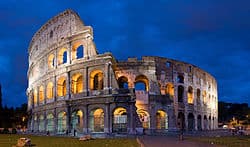Is the Rome Colosseum leaning like the Leaning Tower of Pisa? Well…., the answer is yes and no.

Rome’s Colosseum is not leaning as much as the Leaning Tower of Pisa. Yes Rome’s Colosseum is leaning.
Rome’s Colosseum might be leaning slightly but its stability is not in danger, said officials who on Tuesday announced that the ancient amphitheater is about to undergo its first comprehensive restoration in 73 years.
Experts first noticed the incline about a year ago and have been monitoring it for the past few months, Rossella Rea, director at the 2,000-year-old monument, said in the Italian daily Corriere della Sera.
The paper reported that the Colosseum, famous for hosting bloody gladiator fights in the days of the Roman Empire, is about 40 cm (16 inches) lower on the south side than on the north.

The Italian media described it as the “leaning tower of Pisa effect”.
Prof Giorgio Monti, from La Sapienza’s construction technology department, said there might be a crack in the base below the amphitheater.
“The slab of concrete on which the Colosseum rests, which is like a 13-metre-thick oval doughnut, may have a fracture inside it,” he told the newspaper.
He said intervention could be necessary if the concerns are confirmed, along the lines of stabilization work carried out in Pisa, but he said it was too early to judge what kind of intervention would be most suitable.
“There is no problem with its stability,” Mariarosaria Barbera, Rome’s archaeological superintendent, told a news conference.
“We are talking about a structure whose foundations are 13 meters (40 feet) deep. Roman constructions do not only stand up to centuries, they stand up to millennia,” she said In fact, the Colosseum in Rome is considered one of the greatest works of Roman architecture and Roman engineering.
“We are monitoring it but there is no Tower of Pisa effect,” Barbera said at the unveiling of the 25 million euro restoration project which will start in December and end in 2015.
The project will include the cleaning and restoration of the entire Colosseum, known in Roman times as the Flavian Amphitheater.
It will be carried out in phases so that the Colosseum, which receives hundreds of thousands of visitors a year, will remain open. Only part of it will be covered by scaffolding at any one time.
“The monument is so big that there won’t be too much inconvenience for visitors,” Barbera said.
An underground visitors center will be built under an adjacent piazza, freeing up more areas inside the monument, which are currently used as meeting points and ticket stalls.
Overall, some 25 percent more of the Colosseum will be open to visitors after the restoration, particularly the underground network of tunnels, storerooms and cages.
Two thirds of the underground parts are currently not open to the public.
Rome Mayor Gianni Alemanno said the traffic around the Colosseum will be re-routed by the end of the restoration to decrease damage from vibration. He said at a news conference it would be the first major restoration in 73 years.
“There have been various small projects but nothing of this level has been carried out in all this time,” Alemanno said.
The work is being sponsored by Tod’s, the luxury shoemaker and leather goods company.
Diego Della Valle, chairman of Tod’s said the Colosseum had to be taken care of because “it does not only belong to Italians but to every citizen of the world.”
Capable of seating 50,000 spectators, the Colosseum was used for gladiatorial contests and public spectacles such as mock sea battles, animal hunts, executions, re-enactments of famous battles, and dramas based on Classical mythology. The building ceased to be used for entertainment in the early medieval era. It was later reused for such purposes as housing, workshops, quarters for a religious order, a fortress, a quarry, and a Christian shrine.
Although in the 21st century it stays partially ruined because of damage caused by devastating earthquakes and stone-robbers, the Colosseum is an iconic symbol of Imperial Rome. It is one of Rome’s most popular tourist attractions and still has close connections with the Roman Catholic Church, as each Good Friday the Pope leads a torchlit “Way of the Cross” procession that starts in the area around the Colosseum.
For more about the Rome Colosseum and traveling to Rome click here.
GoItaly is the ItalianTourism.us Italy tours deals blog. GoItaly brings you the cheapest all inclusive Italy vacation deals. All Italy vacation packages and Mediterranean cruises are guaranteed to be unbeatable lowest price. Italy tours with air include all airport transfers. With GoItaly’s exclusive sales you’ll be visiting Venice, Florence, Rome, Amalfi Coast, Sorrento, Sicily, and Tuscany in no time. If you are looking for the best deals on escorted Italy tours, cruises from Rome, cruises from Venice, Amalfi Coast vacations, Tuscany vacations, Northern Italy vacations, Southern Italy vacations, and Rome, Florence, Venice packages then stay tuned to this blog or join us on one of our social networks.